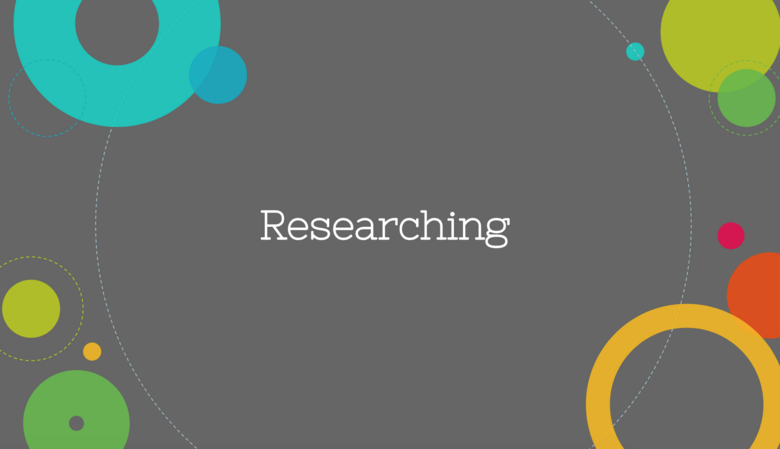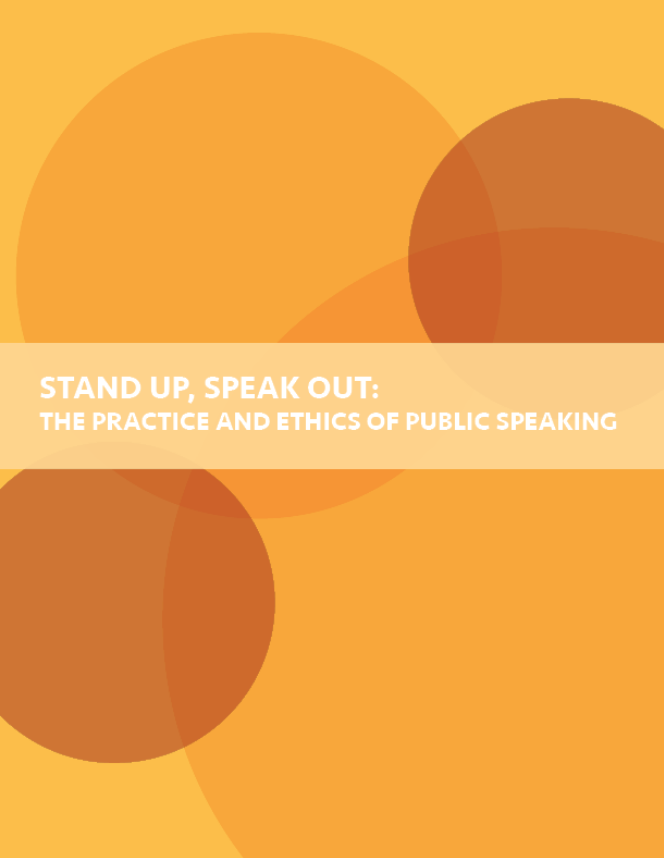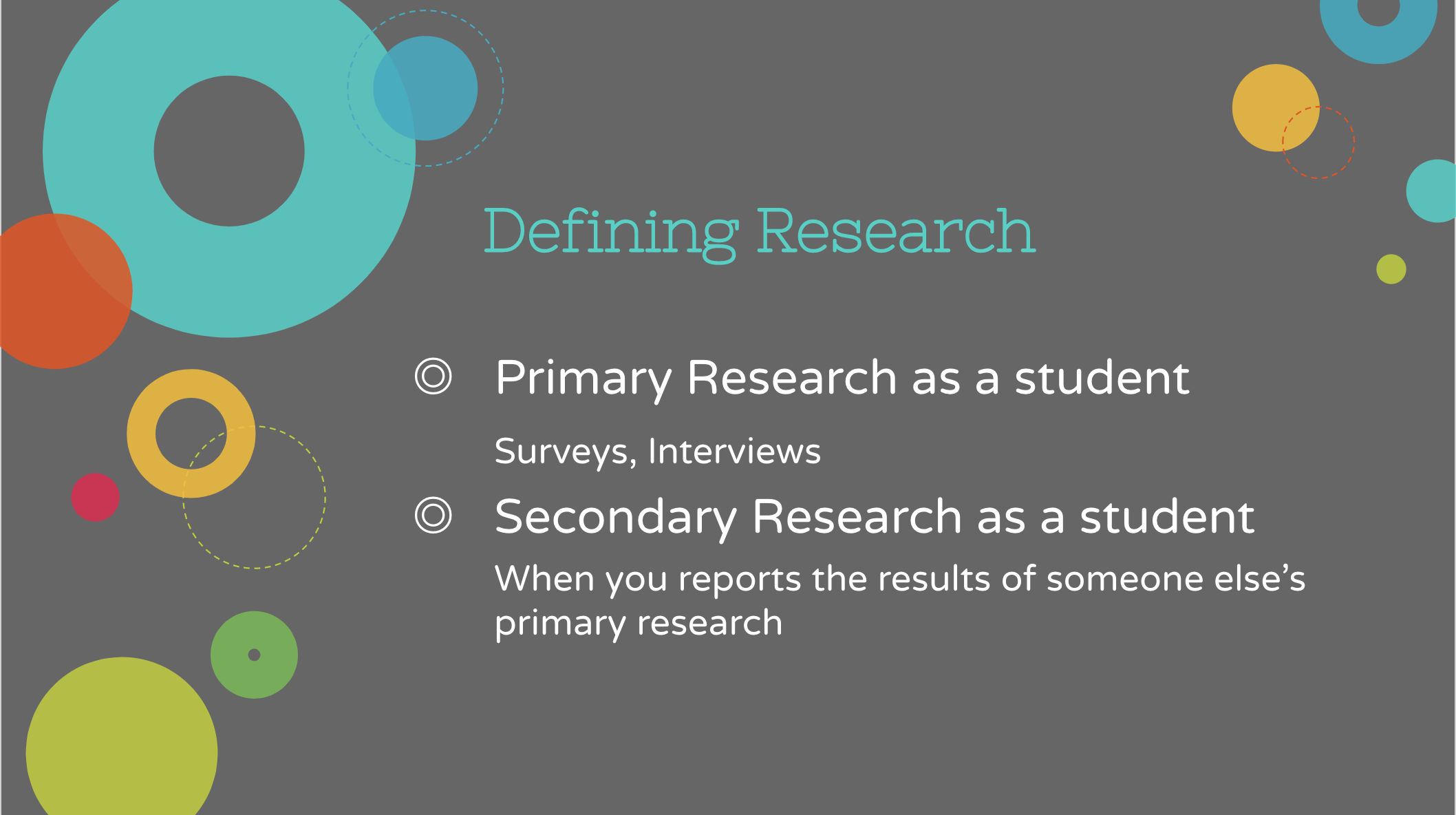Researching Resources

Overview
When thinking about public speaking, many people focus of the act of speech delivery. However, before we can deliver a great speech, we have to write a great speech. That means we need to make sure our content is accurate and meaningful to our audience. Conducting research greatly assists in this process. This section introduces the concept of researching. Students will learn the differences between primary and secondary research, academic and nonacademic research, and MLA and APA source citation styles. This section also discusses plagiarism and how to avoid it by using and citing sources ethically. Students will also learn about the different types of supporting materials along with where and how to gather them. Additionally, students will learn how to assess supporting materials and effectively incorporate them into their speeches.
Learning Objectives
- Understand what it means to conduct research
- Differentiate academic from non academic sources
- Identify and incorporate appropriate sources
- Evaluate the quality of sources
- Understand and avoid plagiarism by using appropriate source documentation styles
(This Module meets the TAG/OCM 013 for a Public Speaking Course; Learning Outcome 4 & 7)
Recommended Textbook Resources
 Stand Up, Speak Out: The Practice and Ethics of Public Speaking
Stand Up, Speak Out: The Practice and Ethics of Public Speaking
- Section 7.1 - What is Research?
- Section 7.2 - Developing a Research Strategy
- Section 7.3 - Citing Sources
- Section 8.1 - Using Research as Support
- Section 8.2 - Exploring Types of Support
There are two chapters that cover the most important aspects of researching. All learning objectives are covered with the content provided. These chapter sections were selected by the team for their comprehensive topic coverage; clear, engaging language, thorough supporting sources from some of the leading scholars in the field; and of course, the publisher’s commitment to open educational resources.
Stand Up, Speak Out: The Practice and Ethics of Public Speaking
- Section 7.1 - What is Research?
- Section 7.2 - Developing a Research Strategy
- Section 7.3 - Citing Sources
- Section 8.1 - Using Research as Support
- Section 8.2 - Exploring Types of Support
There are two chapters that cover the most important aspects of researching. All learning objectives are covered with the content provided. These chapter sections were selected by the team for their comprehensive topic coverage; clear, engaging language, thorough supporting sources from some of the leading scholars in the field; and of course, the publisher’s commitment to open educational resources.
Supplemental Content/Alternative Resources
Video Resources:
Research and Support A Brief Tutorial on Researching and Using Supporting Materials in Public Speaking
Student to Student: Verbal Citiation A Brief Tutorial on Creating and Delivering Verbal Citations in Public Speaking
Quick Tips & Shortcuts for Database Searching: Vanessa Garofalo, Librarian
Popular and Scholarly Sources: The Information Cycle
Learning How to Evaluate Websites: The Hartness Library
Is Wikipedia a Credible Source?
Understanding Plagiarism Staff and Students at York St. John University Talk About What Constitutes as Plagiarism and How to Avoid it
Style Guide Resources:
PowerPoint Slides
Topic Application Section
Classroom Discussion Activity - How Statistics Can be Misleading
(25-45 minutes depending on length of class discussion)
Show this four-minute Ted-Ed presentation on how statistics can be misleading.
Then, begin a classroom discussion with the following prompts:
- What are statistics and why do we use them in public speaking?
- Where can we get the most reliable statistics?
- How do we know if the statistics we have found are accurate?
- How can we use statistical information in our speeches and still be ethical?
- What are some limitations of using too many statistics in your speech?
- Besides statistics, what other types of supporting materials could be misleading?
- What measures must we take as public speakers to maintain our credibility when it comes to research?
Impromptu Speech Activity - A Series of Events, Fortunate or Not!
(45-70 minutes depending on number of students)
This impromptu activity plays off of the Netflix series “Lemony Snicket's A Series of Unfortunate Events.” In this show, “the extraordinary Baudelaire orphans face trials, tribulations and the evil Count Olaf in their fateful quest to unlock long-held family secrets.” The series is narrated by Lemony Snicket himself, often times adding in analogies, narratives, definitions, facts, statistics, and examples throughout the episodes. This impromptu speech activity will allow students to practice a number of public speaking skills including, researching, creating narratives, delivery, and verbal citations.
- Instruct students to form small groups of 3-4.
- Each student must share a brief story about either a favorite memory or a scary/embarrassing memory. (5 minutes)
- Then, each group is tasked with creating ONE cohesive (but ridiculous) fictional story about a “Series of Events” that incorporates elements of each students’ story in the group. The final story should be about 1-2 pages long and take 2-3 minutes to deliver. Students must conduct research (using phones or classroom computers) to add supporting materials to their fictional story. These supporting materials can be statistics, testimony, examples, facts, or definitions that help make the story more effective and vivid. Students must divide the story evenly for an impromptu delivery, each student having a minimum of at least one verbal citation in their section. (10-30 minutes)
- In the spirit of Lemony Snicket’s “A Series of Unfortunate Events”, groups will enthusiastically and dramatically deliver their “Series of Unfortunate (or Fortunate) Events” to the class using handwritten notes. (20-25 minutes)
- Debrief: This should be a fun and exciting activity for the class to learn and practice many public speaking skills and also to establish meaningful connections with their peers. After the entire class has presented, use the following prompts for discussion and reflection: (10 minutes)
- How much did you enjoy listening to these narratives? What can we learn about the effectiveness of narratives in public speaking?
- What kinds of supporting materials did speakers use? Where some more effective than others? Why?
- Were verbal citations complete? Did they help make the story and/or speaker more credible?
- What did you learn most about public speaking from this activity?
- What did you learn most about each other from this activity?
- This impromptu can be graded as an assignment or count for class participation.
End of Section Review
Topic Summary
Conducting research is a vital component of the public speaking process. It takes time, patience, and skill. Knowing where to conduct research and the differences between academic and nonacademic sources are key. Nonacademic sources are good places to start to gain general knowledge on the subject. Scholarly sources offer much more specialized information written by academics, researchers, and other experts. All sources must be diligently evaluated to ensure that you present the most credible and current information. Knowing the many types of supporting materials and how to effectively incorporate them into your speeches will help you become a successful speaker. Last, ethically using those sources means citing them verbally and within your writing to avoid plagiarism.
Key Terms
- Primary Research
- Secondary Research
- Generalizability
- Scholarly (Academic) Sources
- Popular (Non-Academic) Sources
- Plagiarism
- Direct Quotation
- Paraphrase
- Accuracy
- Authority
- Currency
- Objectivity
- Bias
- Vividness
- Statistics
- Definitions
- Examples
- Narratives
- Testimony
- Analogies
Review Questions
- What are the two basic categories of primary research?
- What makes secondary research different from primary?
- What must be considered before you begin conducting research for a speech?
- What are the main differences between academic and nonacademic research?
- How can you effectively evaluate your resources?
- What is the difference between a direct quotation and paraphrasing?
- What is plagiarism and how can you avoid it?
- Why do we use supporting materials in speeches?
- What are the main types of supporting materials to look for when researching?
Critical Thinking/Discussion Questions
- What judgement would you make about the usefulness of Wikipedia in researching a topic for public speaking?
- In what ways are conducting interviews useful in gaining information for public speaking?
- Out of all the elements for evaluating resources, which do you think is the most important and why?
- Think of a recent argument you’ve heard or read. What types of supporting materials were presented...facts, statistics, examples, testimony etc.? Which were the most effective in your opinion? Why? Which were least effective? Why?
- What conclusions can you draw about avoiding plagiarism?
